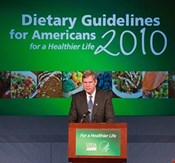Eat less and move more — those are two recommendations among more than 20 included in new federal dietary guidelines.
The U.S. Department of Agriculture (USDA) and Department of Health and Human Services (HHS) released new dietary guidelines last week.
Acknowledging that more than one-third of children and more than two-thirds of adults in the U.S. are overweight or obese, the new Dietary Guidelines for Americans emphasis increased physical activity and calorie reduction.
“These new and improved dietary recommendations give individuals the information to make thoughtful choices of healthier foods in the right portions and to complement those choices with physical activity,” Agriculture Secretary TomVilsack said in a news release. “The bottom line is that most Americans need to trim our waistlines to reduce the risk of developing diet-related chronic disease. Improving our eating habits is not only good for every individual and family, but also for our country.”
The new guidelines include the following 23 Key Recommendations for the general public:
1. Prevent and/or reduce overweight and obesity through improved eating and physical activity behaviors.
2. Control total calorie intake to manage body weight. For people who are overweight or obese, this will mean consuming fewer calories from foods and beverages.
3. Increase physical activity and reduce time spent in sedentary behaviors.
4. Maintain appropriate calorie balance during each stage of life—childhood, adolescence, adulthood, pregnancy and breastfeeding, and older age.
5. Reduce daily sodium intake to less than 2,300 milligrams (mg) and further reduce intake to 1,500 mg among persons who are 51 and older and those of any age who are African American or have hypertension, diabetes, or chronic kidney disease. The 1,500 mg recommendation applies to about half of the U.S. population, including children, and the majority of adults.
6. Consume less than 10 percent of calories from saturated fatty acids by replacing them with monounsaturated and polyunsaturated fatty acids.
7. Consume less than 300 mg per day of dietary cholesterol.
8. Keep trans fatty acid consumption as low as possible, especially by limiting foods that contain synthetic sources of trans fats, such as partially hydrogenated oils, and by limiting other solid fats.
9. Reduce the intake of calories from solid fats and added sugars.
10. Limit the consumption of foods that contain refined grains, especially refined grain foods that contain solid fats, added sugars, and sodium.
11. If alcohol is consumed, it should be consumed in moderation—up to one drink per day for women and two drinks per day for men—and only by adults of legal drinking age.
12. Increase vegetable and fruit intake.
13. Eat a variety of vegetables, especially dark-green and red and orange vegetables and beans and peas.
14. Consume at least half of all grains as whole grains. Increase whole-grain intake by replacing refined grains with whole grains.
15. Increase intake of fat-free or low-fat milk and milk products, such as milk, yogurt, cheese, or fortified soy beverages.
16. Choose a variety of protein foods, which include seafood, lean meat and poultry, eggs, beans and peas, soy products, and unsalted nuts and seeds.
17. Increase the amount and variety of seafood consumed by choosing seafood in place of some meat and poultry.
18. Replace protein foods that are higher in solid fats with choices that are lower in solid fats and calories and/or are sources of oils.
19. Use oils to replace solid fats where possible.
20. Choose foods that provide more potassium, dietary fiber, calcium, and vitamin D, which are nutrients of concern in American diets. These foods include vegetables, fruits, whole grains, and milk and milk products.
21. Select an eating pattern that meets nutrient needs over time at an appropriate calorie level.
22. Account for all foods and beverages consumed and assess how they fit within a total healthy eating pattern.
23. Follow food safety recommendations when preparing and eating foods to reduce the risk of foodborne illnesses.







